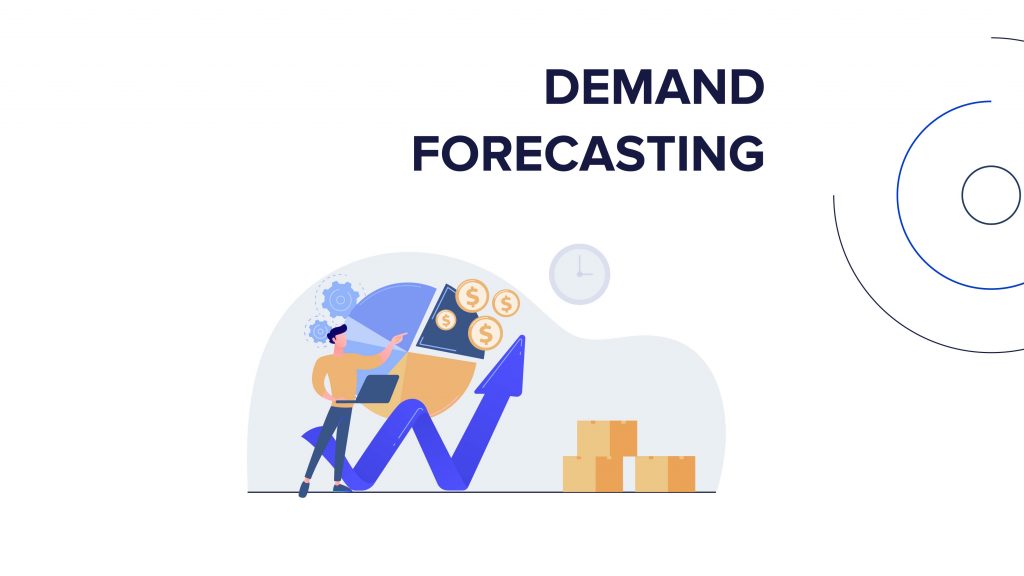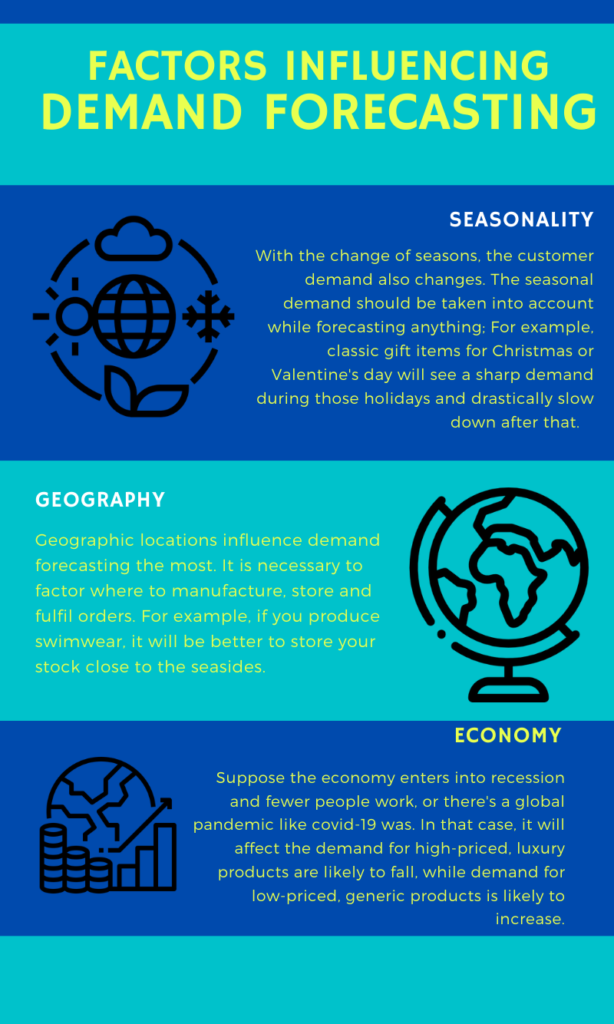With the growing popularity of eCommerce, businesses are under immense pressure to forecast demand accurately. After all, no one wants to be caught short-handed or overstocked. While some companies rush to invest in the latest forecasting technology, others take a more traditional approach. Whatever route you choose, remember that forecasting is an ongoing process, not a one-time event.

Demand forecasting is essential for all eCommerce business owners. Analyzing internal and external risk factors helps reduce uncertainty and ultimately allows you to make more informed decisions about inventory, pricing, and marketing. Forecasting demand can help retailers better understand their customers, identify new opportunities, and make the supply chain more efficient.
There are several models and types of demand forecasting. Today’s research will help the reader get started with the basics and choose what’s best for their business.
Demand Forecasting Definition
Demand forecasting is estimating the future demand for a product or service. The procedure encompasses using historical sales data, market trends, economic indicators, and statistical techniques to estimate future demand. Apart from it, demand forecasting helps understand both the current and prospective customers’ needs.
The historical sales data outlines the past trends in customer demand. It is important to look for any seasonality or cyclicality that might be present. The market trends give an idea about what is happening in the industry and how it might affect demand. For example, changing fashion trends might increase or decrease demand for specific products. Finally, the economic indicators help assess the economy’s health and how it might impact customer spending.
The demand planning system reduces the options of ending up with an obsolete inventory. It also keeps a watch on the demand and supply so there is no shortage of the required product.
Why Is Demand Forecasting Important?
To stay ahead of the competition, businesses must understand what their customers want and need. They also need to anticipate any changes in the market so they can adjust their strategies accordingly. This is where demand forecasting comes in.

Advanced methods allow businesses to make informed inventory, pricing, and marketing decisions. By understanding what customers are likely to buy and when they are likely to buy it, eCommerce stores can stock the right products at the right time. They can also offer promotions and discounts to encourage customers to buy more.
The Lack of Market Demand Forecasting
Poor demand forecasting is one of the main reasons why businesses fail. There are several vivid examples of companies and industries failing due to the lack of proper predictions in history.
Not everyone may remember the 1986 oil price collapse, but it was a result of over-forecasting demand. The Organization of the Petroleum Exporting Countries (OPEC) raised production to meet what they believed would be increased demand. The industry got a $500 billion investment worldwide in 1980 and 1981, with predictions to face a 50% rise in oil prices by 1985. However, the oil demand actually decreased due to a global economic slowdown. The result was a massive oil surplus, massive drilling losses, etc.
The over-optimistic demand forecast by OPEC is not an isolated incident. Flipping through the history pages, you’ll see that all too often, entire industries have been caught off-guard by sudden changes in demand. For example, the travel demand decreased suddenly after 9/11. The terrorist attacks in the US led to a decrease in air travel as people were afraid to fly. The airline industry was not prepared for this sudden change and many airlines went bankrupt.
With the brief introduction of demand forecasting, let’s take a closer look at how contemporary eCommerce sellers can elevate their businesses by leveraging demand forecasting methods.
Six Types of Forecasting
There are multiple methods that companies use for demand and supply forecasting. Businesses use multiple approaches and strategies to see which works better for their products and services. Therefore, not every method will work for every company or product. Practicing various methods to predict the future will help find out the discrepancies quickly and make more accurate predictions.
Here are the main factors influencing demand forecasting:

Passive Forecasting
The passive forecasting method uses sales data from the past. Analytics make comparisons and predictions for future sales at the same time. Retailers using passive forecasting practice short-term forecasts. While it’s suitable for stable products, the method is unsuitable for volatile or changing markets. This method doesn’t consider any external factors that might impact sales in the future.
Active Forecasting
This model is the ultimate choice for everyone having growth phases. Similarly, the same is true for companies starting to increase their sales volumes. With the help of active forecasting tools, businesses can locate potential future demand.
If you practice this method, focus on the current sales and compare them to other related products on the market. If you understand what’s happening in your niche, you can make assumptions about why the demand is growing or falling.
The main idea behind this forecasting strategy is to find out all the external factors that might impact customer demand.
Short-Term Forecasting
The short-term type suits those who manage just-in-time (JIT) stock. However, most companies use this type of forecasting with longer-term projections. It limits the sales predictions from 3-12 months. This is why short-term forecasting is perfect for volatile markets.
This method uses trend analysis to predict future sales. You need to break down the sales data into manageable time chunks. After that, smooth out the spikes and troughs in the data to create an overall trend.
You can use various trend analysis methods, like the moving average or exponential smoothing. The choice of technique depends on your data type and how volatile it is.
Long-Term Forecasting
The long-term type provides data for a more extended period than a year. Consequently, it helps plan for a long-term business production capacity. The strategy projects sales from one to four years into the future. Besides, it works great for planning your marketing, capital investments, and supply chain operations.
Treat it as a roadmap for companies. Moreover, you can use it to make essential business decisions that will shape your company in the years to come.
External Macro Forecasting
Triggering the use of external factors, the macroeconomic type is good for volatile markets. The method projects sales by analyzing global trends, political factors, and economic indicators. You need to understand the global market conditions to make such predictions.
Looking for the business opportunities and threats your company might face would be best. After that, make assumptions and prepare your business to confront or take advantage of them.
In addition, external macro forecasting can help predict even raw material shortages. Companies seeking stability in their supply chains often use this method.
Internal Forecasting
The internal capacity of the companies plays an important role. And here is why internal forecasting is helpful. Imagine a situation when your customer demand doubles. That’s when you start thinking about whether your company will have the capacity to meet the customer demand or not. While using this type to forecast, you will find out the limitations hindering sales growth.
The Benefits of eCommerce Demand Forecasting

Demand forecasting is always essential regardless of your eCommerce store’s size. Above all, it gives sellers predictions as the sales forecasting types do. Statistics show that whereas most salespeople spend over 2.5 hours on forecasting per week, their predictions are less than 75% accurate. With such low accuracy levels, it’s still crucial to use forecasting in your business.
Let’s furtherly explore a few advantages of demand forecasting methods to see why sellers continue to use them:
Seasonal Trends
Many businesses depend on seasonality. Seasonal fluctuations may influence the growth of sales rapidly. Here is why it’s essential to know which months may be beneficial and have less customer demand. For example, if your sales grow higher every January, you can offer discounts to keep your customers engaged. In other words, demand forecasting helps to reveal seasonal trends.
Pricing Strategy
Demand forecasting helps provide an accurate price for products. However, it requires a good understanding of the marketplace and competitors. If a seller wants to keep up with current trends and not lag behind their competitors, they should predict customer demand clearly. It would be best to consider the customer’s willingness to pay (WTP). It would help if you found that sweet spot where customers are happy to pay for the goods, and the seller makes a good profit.
Demand forecasting helps have accurate budgeting as well. In that way, it’s possible to reduce the discrepancies in the companies’ cash flow
Accurate Inventory Management
Inaccurate inventory planning is one of the most significant issues most eCommerce sellers face. Most businesses fail to forecast consumer demand accurately, resulting in too much or too little inventory. Inevitably they end up with dead stock or, even worse, lost sales.
Forecasting inventory needs lets businesses manage their stock more efficiently and avoid the waste of overstocking or the cost of understocking. By predicting consumer demand, businesses can also keep the proper inventory on hand, ensuring they always have what their customers look for.
However, it is not advised to rely on the forecasting methods only. Inventory management software solutions like eSwap will be the best solution to prevent eCommerce stock issues. Software features like order management, inventory management, and workflow automation will do your job. Sellers using advanced technology for inventory management are 1.5 times more likely to exceed their quarterly revenue goals by 10% or more. If that’s not enough, most of those using inventory management software also claim it helped them make better decisions about their inventory.
If that’s what you’re seeking for your eCommerce store, request a free demo today to see what a platform like eSwap can do for you.
Conclusion
Demand forecasting is vital for all eCommerce business owners. It would be best to use demand forecasting to predict future sales and reduce risks. A solid understanding of the marketplace and your competitors is essential to setting the right price.
Today’s research dwelled upon why demand forecasting is critical and why you should use it in your eCommerce business. You’ve also learned about the benefits of inventory management software and how it can help you make better decisions about your future. If you’re looking for a solution that combines demand forecasting with inventory, warehouse, and internal workflow management, eSwap is the right platform for you!







